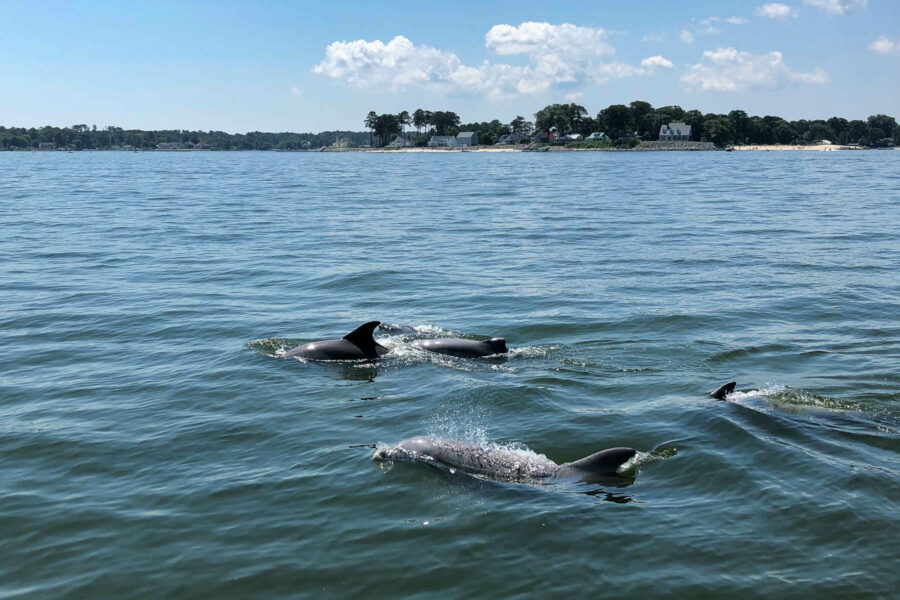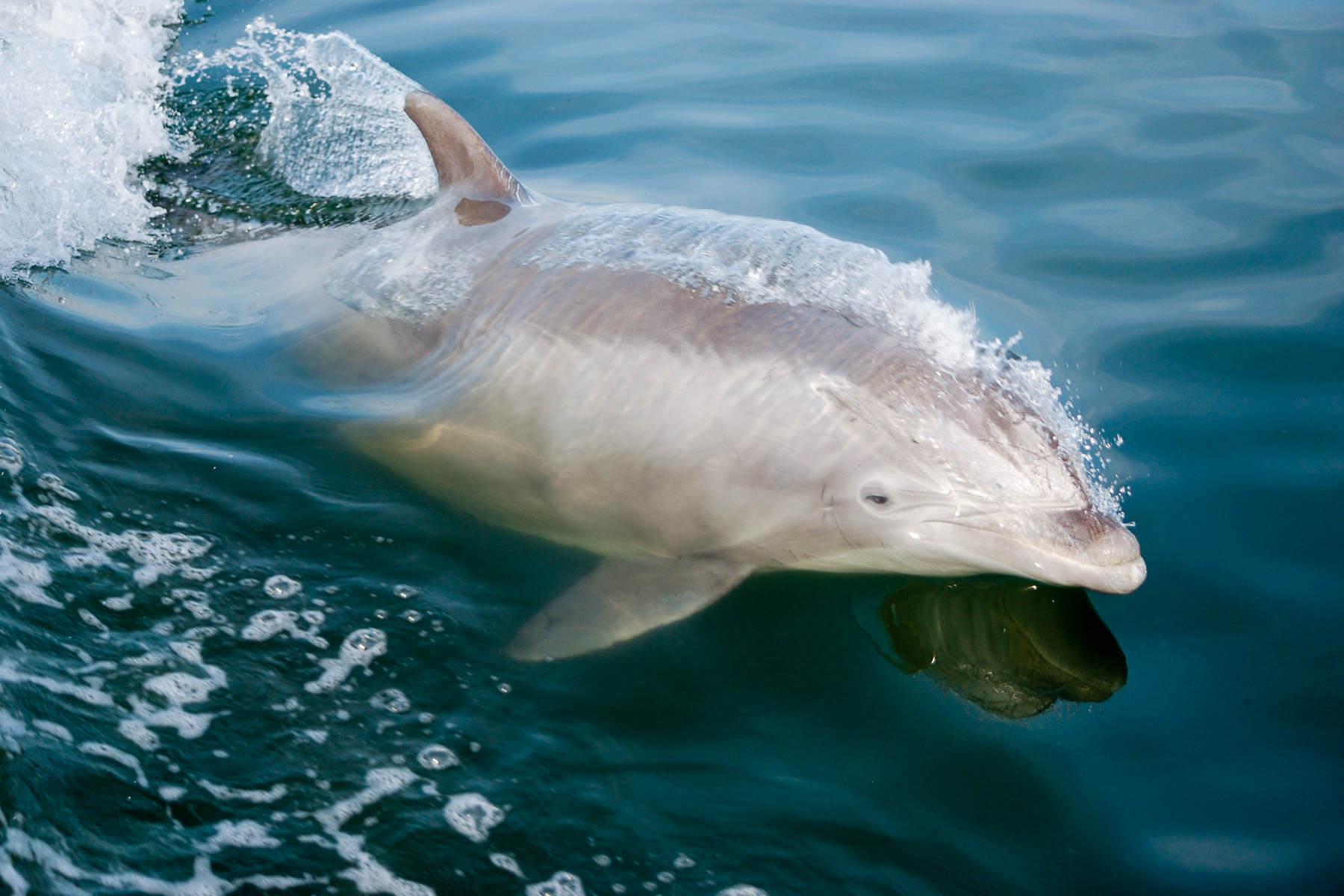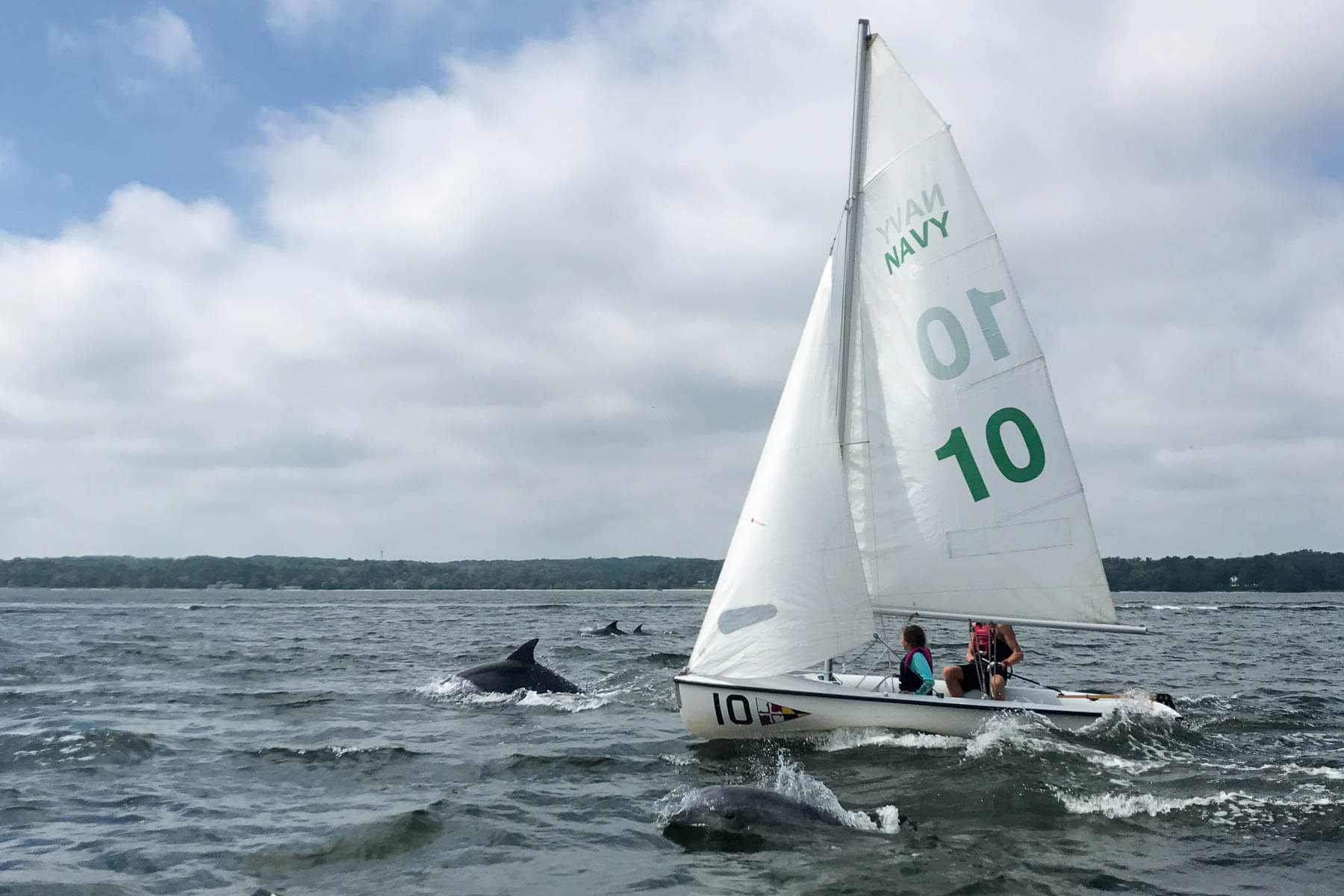Are there dolphins in the Chesapeake Bay?

The Chesapeake Bay is home to more than 3,600 local and migratory species, among which is the charismatic, yet elusive bottlenose dolphin. While bottlenose dolphins are a well-studied species, there is much to learn about their presence in the Chesapeake Bay. Scientists are focused on determining how many dolphins are in the Bay, when they appear, why those sightings have increased, and in which rivers and tributaries these benevolent mammals are most active.
There are historical accounts of the bottlenose dolphin showing up in Chesapeake waters as far back as 1884, according to the Bay Journal, though sitings were uncommon throughout the 20th century. In 2013, the population also took a tragic plunge when an outbreak of cetacean morbillivirus, a type of virus, caused the death of thousands of bottlenose dolphins along the east coast. Thankfully, the population is recovering and has been protected under the Marine Mammal Protection Act. Experts now report a flurry of dolphin activity in the Bay, generating excitement and curiosity among residents, environmentalists and scientists alike.
Janet Mann, Ph.D., professor of biology and psychology at Georgetown University, along with Ann-Marie Jacoby, Ph.D research assistant at Duke University, leads the Potomac-Chesapeake Dolphin Project, which intensively studies individual bottlenose dolphins that visit the Potomac River. The Potomac is a convenient area in the middle of the Bay, and as one of the widest tributaries of the Bay with deeper water, it provides Mann and Jacoby the opportunity to study two different subspecies populations of bottlenose dolphins; coastal and estuarine.

Working to track the migratory patterns of dolphins, Mann and Jacoby collect images of dolphins with uniquely shaped, scarred and pigmented dorsal fins. These images are then matched with other photographs within the Mid-Atlantic Bottlenose Dolphin Catalog to see where they’ve been.
According to Jacoby, “We have matched individuals in the Potomac River to animals in North Carolina in the winter months, and then we also have (dolphins) that we have matched in New Jersey. This supports that we have two different ecotypes of dolphins mixing in the Bay.”
As you can imagine, keeping up with dolphins is hard work. In an effort to crowdsource dolphin monitoring, Mann has joined forces with Dr. Helen Bailey, an associate research professor at the University of Maryland Center for Environmental Science’s Chesapeake Biological Laboratory, who launched Chesapeake DolphinWatch, an online or smartphone app tracking system that collects reported sightings and information throughout the Bay. The app has been used by nearly 6,000 enthusiastic community scientists, turning it into a valuable scientific database.
“The citizen scientists have played a crucial role,” said Professor Bailey. “There is no way that my small group of scientists would have been able to cover the whole Bay, we just wouldn't have had the resources to do that. So, this network of observers has really played a key role.”

Through coordinated efforts, Mann and Bailey have discovered significant populations of bottlenose dolphins, sometimes traveling in surprisingly large pods. In 2018, there were 1,129 dolphin sightings reported through Chesapeake DolphinWatch, of which, 855 were confirmed by checking individual reports for supporting evidence, such as photographs, and by listening to recorded communications between dolphins using underwater microphones. Bailey believes that there are probably over 1,000 dolphins swimming in and out of the Bay to socialize, feed and give birth. Sightings of dolphins occur throughout most of the Bay between April and October with the peak season occurring in early July. High-density locations include the Potomac River, the Chester River and areas near the Chesapeake Bay Bridge.
“The Chesapeake Bay may be a very important resource for dolphins, and it needs to be known and taken into consideration with the current management of these animals,” said Mann. “We are hoping that the work we are doing not only excites people about wildlife in the Chesapeake but that it will also be used to guide management.”
Community science programs such as Chesapeake DolphinWatch are a rising trend in Bay conservation. Throughout the watershed, the public has assisted in programs such as water quality sampling, tree planting, underwater grass monitoring, bird banding and more. These opportunities provide a gateway for residents to learn about the ecosystem in which they live while improving the health of the Bay and helping us better understand and protect wildlife.
Interested in using your free time to save the planet? Check out other opportunities to get involved in community science programs in the Chesapeake region.

Comments
Was out in the Chesapeake bay on sat July 18 2021 out in front of Rod and Reel restaurant and was following at least a hundred dolphins with their 2-3 ft babies so cool was following to Harrington harbor and back for at least two hours till I broke away to help a wrecked couple on a jet ski helped them on their way and true lily made my day seeing them rite up against my boat have many videos
When I was a child many years ago, our family had a summer cottage in Deltaville, Virginia at the mouth of the Rappahannock River, as it emptied into the Chesapeake Bay. I can remember, as I bounced along in my 14ft. runabout, I would see many dolphins and some would swim rather close alongside me. I was so small, I'm sure the dolphins wondered if anyone was driving the boat. I'm currently writing a book and came across an organization in Seattle, Washington named thewhaletrail.org. Check it out.
I really liked your article about there being dolphins in the Chesapeake Bay. I'm a Boy Scout with Troop 441 in Pasadena and am working on my communication merit badge. As a requirement I wrote a 5 minute speech on protecting the bay. In my speech I talked about protecting the bay by picking up trash, planting trees and educating people about the bay. I hope that we can continue to persevere the bay so that dolphins and other sea life will be safe and unharmed in the Chesapeake Bay.
Several years ago a friend and I were kayaking on Langford Creek off Chester River. We were visited by 3 or 4 dolphins in the mouth of Davis Creek. I did not have the presence of mind to take a picture but my friend did.
reCAPTCHA is an insult to your readers!
Thank you!
Your comment has been received. Before it can be published, the comment will be reviewed by our team to ensure it adheres with our rules of engagement.
Back to recent stories